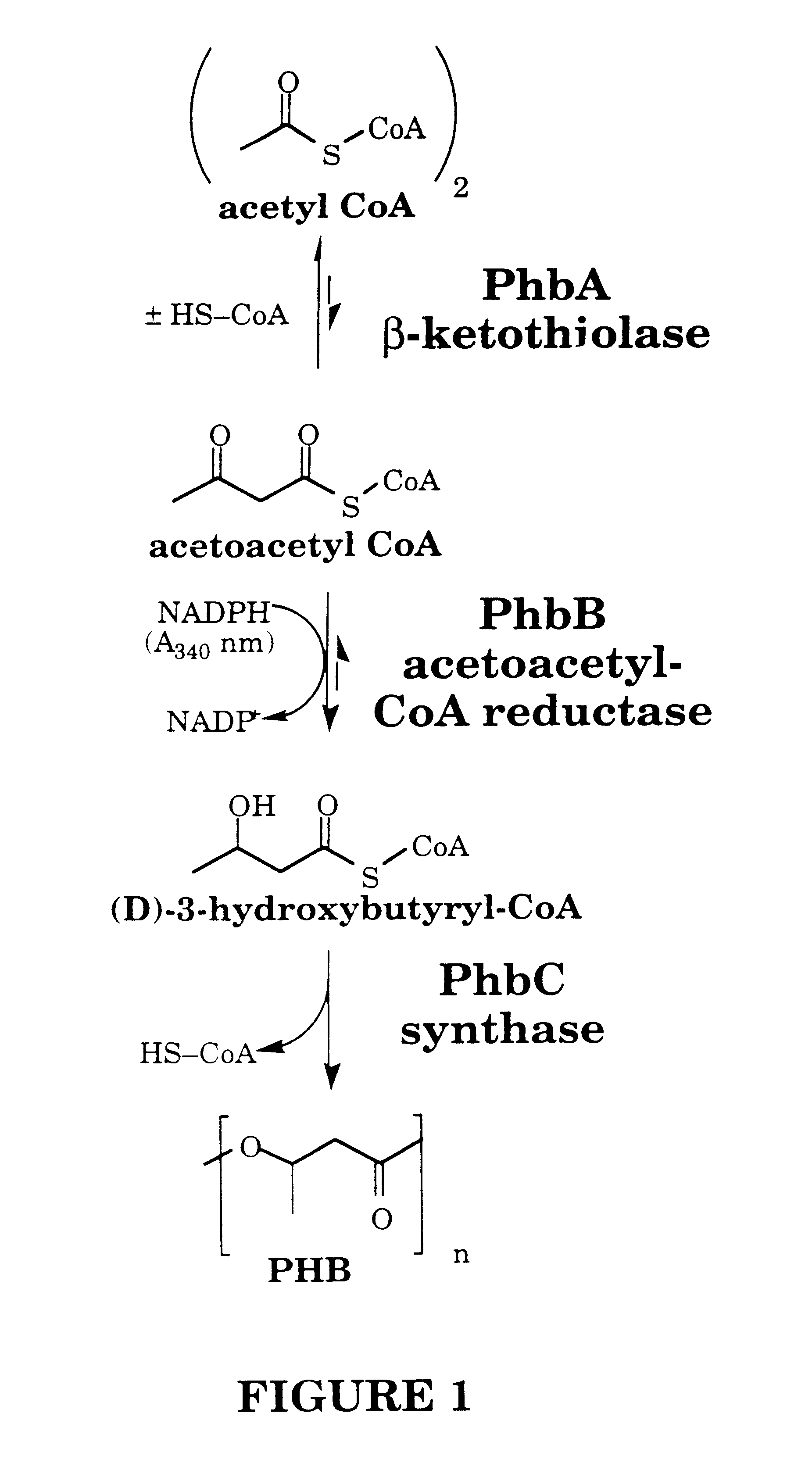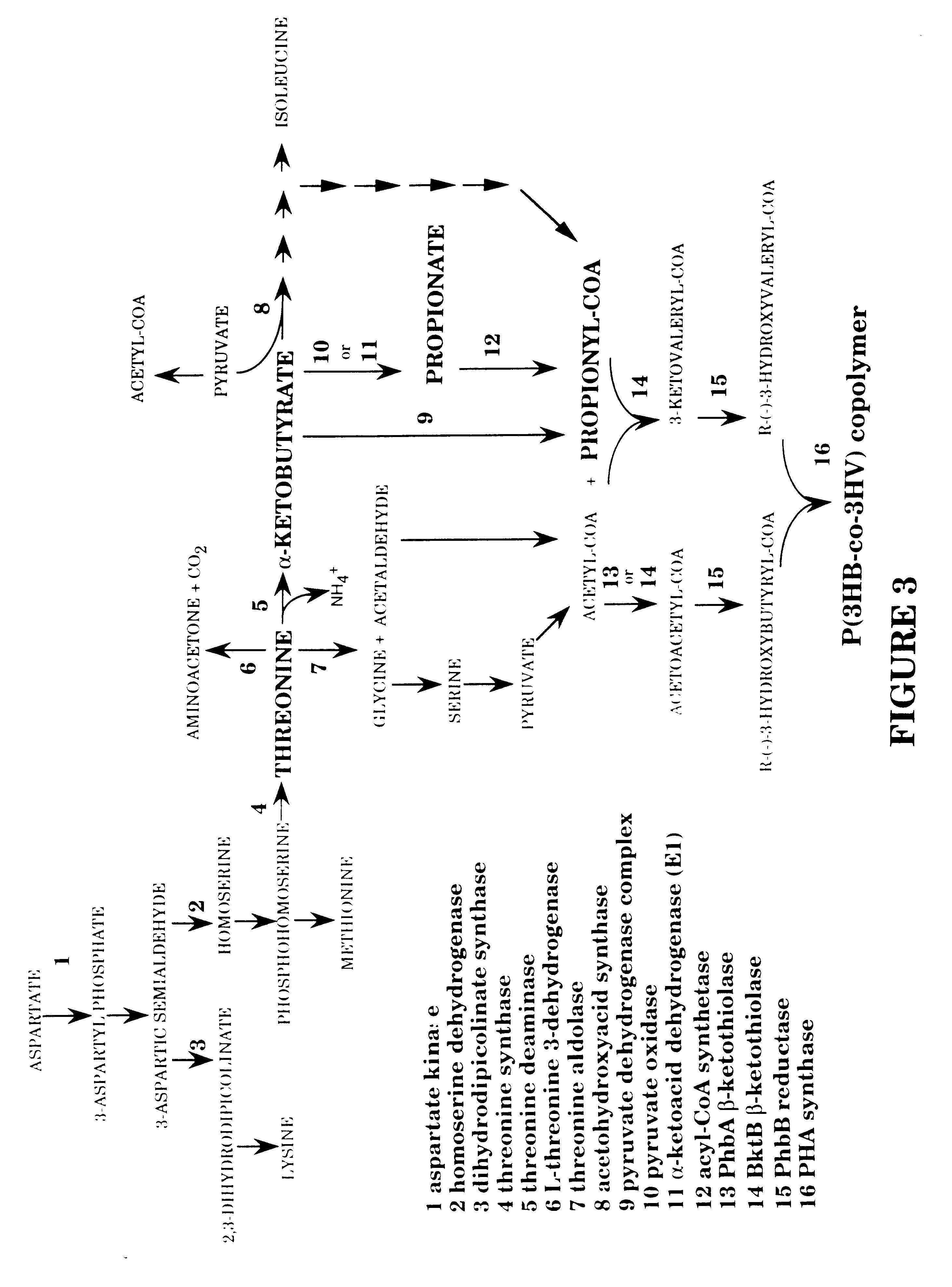Polyhydroxyalkanoates of narrow molecular weight distribution prepared in transgenic plants
a technology of polyhydroxyalkanoates and transgenic plants, which is applied in the field of genetically engineered plants and bacteria, can solve the problems of inability to commercialize p(3hb-co3hv) copolymer, limited use of p(3hb-co3hv) copolymer to low-volume specialty applications, and inability to demonstrate the production of this polymer in plants
- Summary
- Abstract
- Description
- Claims
- Application Information
AI Technical Summary
Problems solved by technology
Method used
Image
Examples
example 2
Increased Production of .alpha.-Ketobutyrate From L-Threonine Via Modified E. coli Biosynthetic Threonine Deaminases
L-threonine can be degraded by several metabolic routes (FIG. 3). Threonine aldolase (E.C. 4.1.2.5), a pyridoxal phosphate-containing enzyme, catalyzes threonine degradation to produce glycine and acetaldehyde, both of which can be metabolized to acetyl-CoA (Marcus and Dekker, 1993). Acetyl-CoA is the precursor of the C4 monomer in PHB (FIG. 1). L-threonine 3-dehydrogenase (E.C. 1.1.1.103) converts threonine into aminoacetone and CO.sub.2 (Boylan and Dekker, 1981). Alternatively, L-threonine can be converted to .alpha.-ketobutyrate by threonine deaminase (also designated threonine dehydratase, E.C. 4.2.1.16), as shown in FIG. 3. .alpha.-ketobutyrate is a direct metabolic precursor of propionyl-CoA (FIG. 3). There is also competition for .alpha.-ketobutyrate in isoleucine biosynthesis (FIG. 3), and in transamination to produce 2-aminobutyrate (Shaner and Singh, 1993).
Bi...
example 3
Increased Production of .alpha.-Ketobutyrate Via Use of the Threonine Deaminase of Rhodospirillum rubrum
The phototrophic, non-sulfur purple bacterium Rhodospirillum rubrum (ATCC 25903) is the source of a natural deregulated threonine deaminase (Feldberg and Datta, 1971). As shown in Tables 1 and 2, above, the threonine deaminase from R. rubrum displays normal Michaelis-Menten behavior, and is not significantly feedback inhibited by isoleucine. This enzyme is also unaffected by activators of the degradative enzyme (Feldberg and Datta, 1971). The R. rubrum threonine deaminase can therefore also be expressed in bacteria and plants in order to enhance the production of .alpha.-ketobutyrate from L-threonine.
SDS-PAGE analysis indicates that the monomeric molecular weight of the R. rubrum threonine deaminase is approximately 42 kD (data not shown). This is intermediate between the molecular weight of the E. coli biosynthetic (56 kD) and biodegradative enzymes (35 kD). The R. rubrum enzyme ...
example 4
Increased Production of .alpha.-Ketobutyrate Using Other Modified or Naturally-Occurring Forms of Threonine Deaminase
Deregulated threonine deaminases useful in the present invention can be either naturally-occurring, or produced by recombinant DNA techniques such as those employed in Example 2. If naturally-occurring, such threonine deaminases can be identified by screening organisms for threonine deaminase activity, followed by measuring the sensitivity of that activity to isoleucine inhibition using the standard assay methods described above. Genes for these enzymes can then be isolated by complementation into threonine deaminase-negative bacteria (Fisher and Eisenstein, 1993). The levels of isoleucine analogs such a L-O-methylthreonine (OMT) in the growth medium can be varied during the complementation procedure to select organisms that express isoleucine-deregulated biosynthetic threonine deaminases. Alternatively, genes for threonine deaminases can be obtained by hybridization ...
PUM
| Property | Measurement | Unit |
|---|---|---|
| molecular weight distribution | aaaaa | aaaaa |
| molecular weight distribution | aaaaa | aaaaa |
| molecular weight distribution | aaaaa | aaaaa |
Abstract
Description
Claims
Application Information
 Login to View More
Login to View More - R&D
- Intellectual Property
- Life Sciences
- Materials
- Tech Scout
- Unparalleled Data Quality
- Higher Quality Content
- 60% Fewer Hallucinations
Browse by: Latest US Patents, China's latest patents, Technical Efficacy Thesaurus, Application Domain, Technology Topic, Popular Technical Reports.
© 2025 PatSnap. All rights reserved.Legal|Privacy policy|Modern Slavery Act Transparency Statement|Sitemap|About US| Contact US: help@patsnap.com



